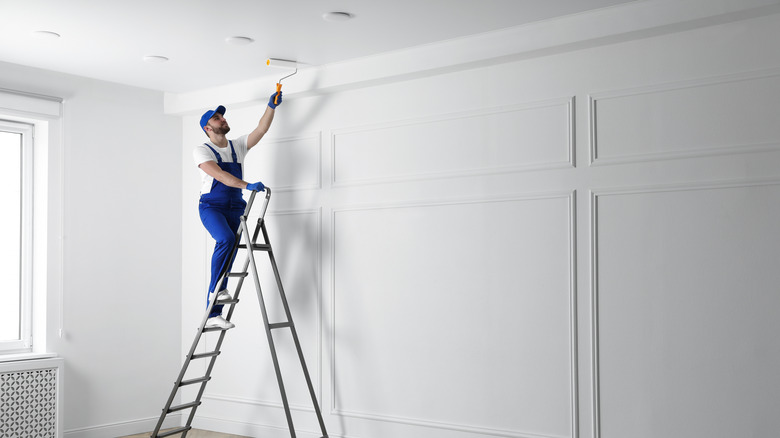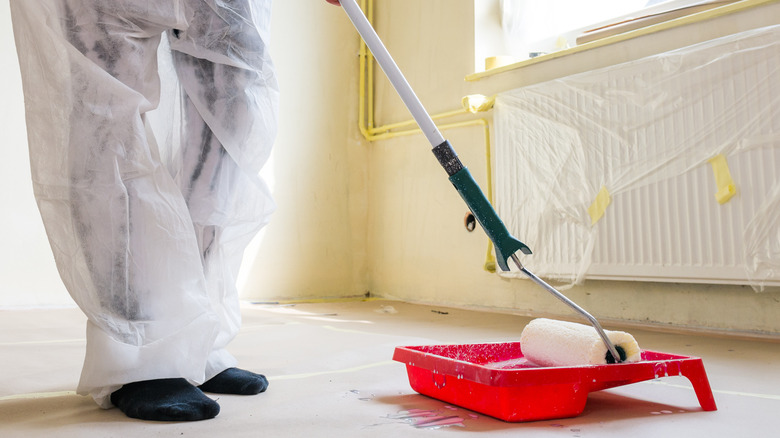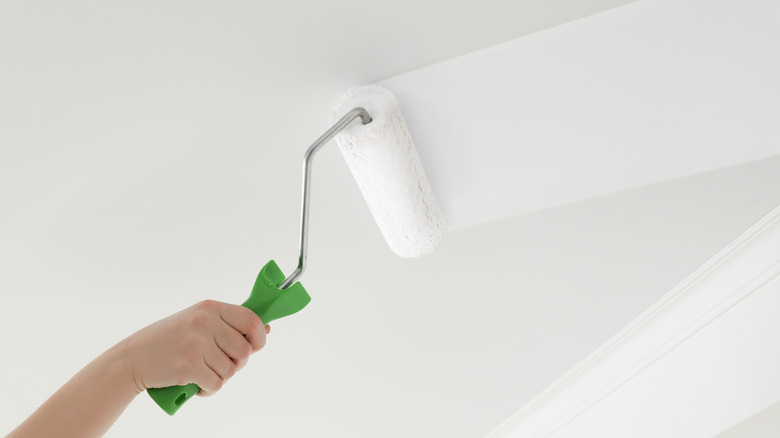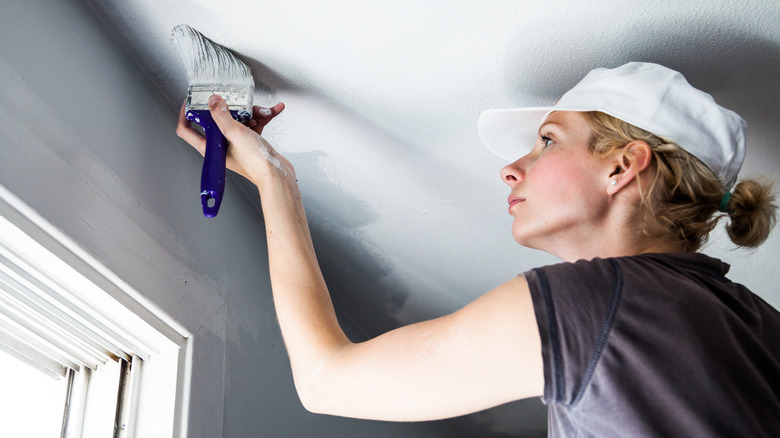How To Easily Paint Your Ceiling
Painting your ceiling doesn't have to be hard. While it will take some prep work to get the best outcome, it will be worth it in the long run. Choosing the color of your ceiling is the most important step. White is the most common color chosen for ceilings because it reflects light and makes the room appear larger. Although choosing a color a few shades darker than the walls creates contrast and depth, according to Architectural Digest.
Before priming and painting your ceiling, you will need to spackle any cracks and clean it. To do this, use a broom to brush off any dust or spiderwebs in the corners. If you don't clean your ceiling, the paint won't be able to adhere properly. If there are any stains from things like water leaks, you will need to use a special stain-blocking primer, so the stain doesn't seep through. When priming, you may need to do multiple coats depending on if you're going from a darker to a lighter color. To get the proper coverage, Architectural Digest suggests that you do two coats of primer and two coats of paint.
Use the right tools
To paint your ceilings, you'll obviously need a paintbrush or roller, trays, and paint — but there are some other key tools that can make your project faster and smoother. Using an interior latex paint with a high viscosity (106 KU or higher) will help the paint stick to the ceiling until it dries without dripping. Be careful not to drip paint onto yourself, especially in your eyes or hair. Wear a protective painting suit or old clothing, goggles, and a hat. Protect furniture, rugs, and floors by removing them from the room or covering them in painter's masking film. It can also be helpful to have a friend or partner nearby to hand you items and make the painting process easier.
You may want to keep your ladder nearby for cutting edges and applying touchups, but don't paint the whole ceiling this way! An extension pole will help your roller reach the ceiling without straining your back and arms. Extension poles usually come in adjustable lengths between 4 feet and 24 feet. You'll want an extension pole that will reach the height of your ceiling without too much effort. For an 8-foot ceiling, an extension pole that adjusts up to 8 feet should be sufficient. You may also want to purchase an extendable paintbrush, which attaches to the end of your pole and allows you to reach the ceiling without a ladder.
Take your time
Once you've done all your prep work, it's time to start painting. Move as much furniture out of the room as you can — otherwise, put a plastic drop cloth over the furniture and floors to protect them from paint splatters. Even if you are being careful, it's important to protect your things just in case. It's easier to prevent the paint from staining carpet or wood floors than to remove it after drying.
It's recommended to use a ⅜-inch roller for ceilings. "Any more texture than a basic ½-inch [nap] is a no-go," said Jay Walker, an NYC-based TaskRabbit, in a talk with Architectural Digest. Walker also recommended moving slowly — you should roll the paint on slower and with less pressure than you would on a wall. To prevent drips while you're lifting the paint roller to the ceiling, you can rotate the roller from the handle as you lift it up.
Work from the outside in
If you're painting a bare room, always paint the ceiling before the walls. This way, if any paint splatters on the walls, you can wipe it up with a damp rag before it hardens and hide any leftover discoloration under wall paint later. Love your existing wall color already? Cover the walls with painter's masking film to protect them from ceiling drips. When you're ready to paint, start by cutting the edges in one corner of the room, painting out about 2-3 inches from where the ceiling meets the walls. Immediately after edging out a corner, come in with a 2-inch trim brush while the paint is still wet. Paint the corner section and drag out the edges to reduce visible brushstroke lines. Continue edging and painting until you create a solid border around the room.
Now it's time to fill in the rest of the ceiling! Gently coat your roller in paint, being careful not to soak it too heavily and risk drips and splatters. Attach the roller to an extension pole and begin rolling it across the ceiling in zig-zag strokes until the roller is almost empty. Follow up with straight and even strokes in the opposite direction to fill in the area and blend in any brushstrokes. Continue until the whole room is covered, then allow the ceiling to dry completely before applying a second coat.



